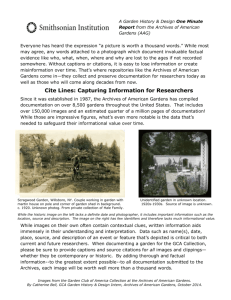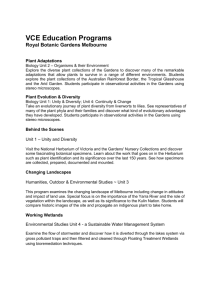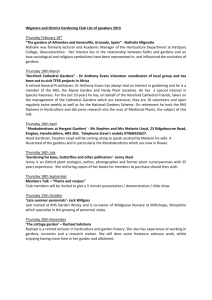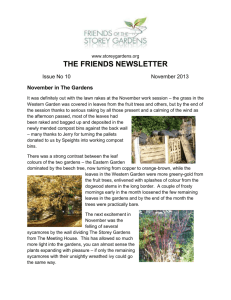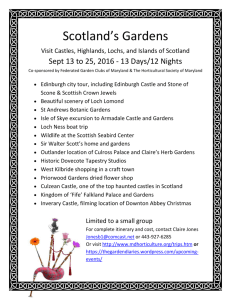People, Plants, Collections: Making the Connections
advertisement
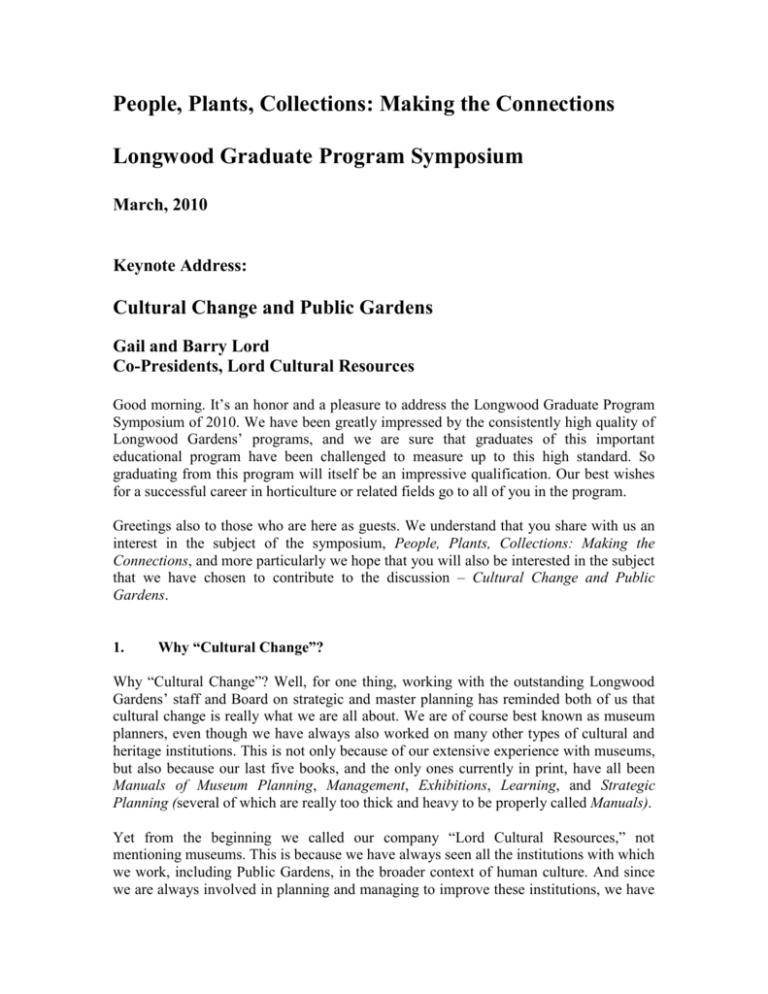
People, Plants, Collections: Making the Connections Longwood Graduate Program Symposium March, 2010 Keynote Address: Cultural Change and Public Gardens Gail and Barry Lord Co-Presidents, Lord Cultural Resources Good morning. It’s an honor and a pleasure to address the Longwood Graduate Program Symposium of 2010. We have been greatly impressed by the consistently high quality of Longwood Gardens’ programs, and we are sure that graduates of this important educational program have been challenged to measure up to this high standard. So graduating from this program will itself be an impressive qualification. Our best wishes for a successful career in horticulture or related fields go to all of you in the program. Greetings also to those who are here as guests. We understand that you share with us an interest in the subject of the symposium, People, Plants, Collections: Making the Connections, and more particularly we hope that you will also be interested in the subject that we have chosen to contribute to the discussion – Cultural Change and Public Gardens. 1. Why “Cultural Change”? Why “Cultural Change”? Well, for one thing, working with the outstanding Longwood Gardens’ staff and Board on strategic and master planning has reminded both of us that cultural change is really what we are all about. We are of course best known as museum planners, even though we have always also worked on many other types of cultural and heritage institutions. This is not only because of our extensive experience with museums, but also because our last five books, and the only ones currently in print, have all been Manuals of Museum Planning, Management, Exhibitions, Learning, and Strategic Planning (several of which are really too thick and heavy to be properly called Manuals). Yet from the beginning we called our company “Lord Cultural Resources,” not mentioning museums. This is because we have always seen all the institutions with which we work, including Public Gardens, in the broader context of human culture. And since we are always involved in planning and managing to improve these institutions, we have recently come to understand that what we have been working on all these years is essentially cultural change. So our next book, due to appear in a couple of months, is entitled Artists, Patrons and the Public: Why Culture Changes. Applying the approach of the new book to public gardens, we see right away the connections between people that are the subject of this symposium: 2. Patrons of gardens were originally royals, nobles and priests. In America, they were very often captains of industry, as at Longwood Gardens (Pierre Dupont), Biltmore House (George Vanderbilt) or Vizcaya (James Deering) in Miami. Today they are the Boards that administer the trusts or foundations that direct public gardens, or they may be elected or appointed government officials at various levels who are responsible for city, county, state or national parks or garden systems. When we worked on a Master Plan for Vizcaya, we reported to a Board appointed by Miami-Dade County. The public is vast and enthusiastic, including dedicated gardeners, families out for fun, romantic young couples, serious students, school kids off a bus, pensioners dragging campers, tourists from the next state, and sophisticated foreigners familiar with some of the great gardens of Europe or Asia. And the artists are – or can be -- each of you, the horticulturalists, planting and growing the living plant collections, sensing what is changing in the world around you, and then planning, designing and installing new gardens, new displays or new learning or entertainment programs. When the patrons and the public respond to your innovations, the connection has been made, and cultural change can happen. Culture and Gardens But what is culture and what does it have to do with public gardens? If we look at the etymology of the word “culture”, we find that the two are not far apart: the Latin root of our word “culture” is derived from the past participle of the verb “colare,” meaning “to tend to”, “to care for” or “to preserve.” In fact, the medieval usage of “cultura” and its variants in western European languages referred to cultivation of the land – including not only agriculture but also horticulture – at a time when land was the chief source of wealth. Horticultural collections were already being assembled in Europe’s monasteries, and documented in herbals, primarily for medicinal purposes. As early as the beginning of the 9th century, there was even what we could call a “Collection Development Strategy” – the Capitulare de Villis, a list of plants for town gardens compiled by Charlemagne’s court around the year 800. It was during the Renaissance in the late 15th and early 16th centuries, when land was no longer the only significant source of wealth and intellectual pursuits took on a new importance in all aspects of society, that the word “cultura” and its variants in diverse languages began to be used as a metaphor to refer to cultivation of the mind. As you know, it was also during the Renaissance that Italian patrons – first, wealthy bankers like the Medici’s in Florence and then the Pope and his Cardinals in Rome – aspired to emulate the villas of ancient Rome by commissioning great gardens like the Villa Medici in Fiesole (1450) or the Villa Madama, designed by Raphael to offer a view of the Tiber in 1518. Even more important for our subject, in 1544 the scholar Luca Ghini (1490-1556) established Italy’s first public garden on the campus of the University of Pisa. He assembled an herbarium, or hortus siccus, as he would have called it, meaning a collection of dried plants. And he aspired to display a “systems garden”, planting what we might call systematic “order beds” in order to show related species. Today we might use the term “visible storage” for his display concept. By situating the first botanical garden in an academic context, Ghini demonstrates the close relationship between public gardens and the Renaissance’s metaphorical meaning of “culture” to refer to cultivation of the mind. The 18th century Enlightenment further generalized the metaphorical use of the term “cultura” and its variants to reference more broadly the values and ideas of a whole society. By the following century Matthew Arnold (in his book Culture and Anarchy) was using the word in somewhat the same way as we do today. Even though Arnold and other Victorians may have wished to restrict its use to the values and ideas of the upper classes, there was throughout both 18th and 19th centuries a steady development of more and more public gardens, such as the Royal Botanic Garden at Kew, which celebrated its Bicentennial just six years ago. 3. Enclosure as a Cultural Concept The word “garden” is derived from Old English “garth”, defined simply as an enclosed yard. “Enclosure” is also the essential meaning of three other terms historically associated with gardens – “hortus conclusus” in the Middle Ages evoked a spiritual as well as a physical enclosed garden; “cloister” meant and still means an enclosed area within a religious or monastic establishment; and much earlier, “Paridaeza,” literally meaning “wall around”, was the Farsi word for the enclosed four-square Persian garden that Alexander’s officers brought back to their Greek dominions from Egypt to Sicily, where they emulated the gardens that they had enjoyed after their conquest of Persia, subsequently inspiring the Romans to design their villas on this Hellenistic model. Hellenistic Greeks’ use of this word that we know as “paradise” was then applied to the Bible’s Garden of Eden, the protective enclosure from which Adam and Eve were expelled after they had sampled the fruit of the tree of knowledge – a profoundly cultural and simultaneously horticultural myth about the origins of sin and the need for salvation. “Enclosure” is thus a fundamentally cultural concept. Nature is not enclosed, and although some other animals may defend their claims over a given terrain, only homo sapiens encloses land. “Enclosing” is the active verb in Enlightenment philosopher JeanJacques Rousseau’s famous thesis of the basis of civilization: “le premier qui, ayant enclos un terrain, s’avisa de dire “Ceci est à moi” était le vrai fondateur de la société civile”(the first person who, having enclosed an area, took it into his head to say “This is mine” was the true founder of civilization.) 4. The Public Garden: Admitting the Public into the Enclosure So “enclosure” is at the root of culture, and is also the defining characteristic of gardens. Seeing this link allows us to appreciate the profoundly democratic – indeed, revolutionary – meaning of the term “Public Gardens”. Enclosed gardens in ancient Egypt, Mesopotamia, India, China or Japan had always meant areas reserved for royalty, the nobility or the priestly class. The establishment of public gardens, beginning in the Renaissance but really flourishing in the Enlightenment and thereafter, makes the truly revolutionary claim that the general public also has a right to its share of “paradise” – to be admitted into the enclosure. In 1789, for instance (the very year of the French Revolution), the Englischer Garten, Germany’s first public park, opened in Munich, designed in the English manner of Capability Brown with serpentine paths offering vistas of both the city and the Hirschangerwald, an old forest; today it continues its traditional role as a free public amenity, favored for clothes-optional sunbathing in summer. In England itself some of the earliest attempts at public gardens, such as the 18th-century “tea gardens,” were denounced from the pulpit as places of scandal, since they were known to be places of assignation where unmarried couples could arrange to meet. Although it had admitted general visitors earlier, it was not until 1840 that the Royal Botanical Gardens at Kew was officially transferred from Royal to public custody. In America this movement had its origins, not surprisingly, in Boston. The Boston Common is America’s oldest public park, established in 1634, modeled on medieval Europe’s “commons”, a common pasture to be shared by everyone’s cattle, and a broad open space where laundry could be spread to dry. It was also the place for public hangings – the gallows were not removed until 1817, and only in 1830 was the grazing of cows forbidden. In 1859 the Commons was joined across the street by Boston’s Public Gardens, the first botanical public garden in the U.S. 5. Collections and their Curators As we have already noted in the earliest example at Pisa, forming collections of both dried and living plants has always been at the heart of public gardens. The Flora that Renaissance scholars began publishing, replacing the medieval herbals, were systematic studies of plants aimed at establishing a philosophical basis for the classification of plants they were collecting -- a quest for order that was ultimately resolved only in the Enlightenment by the great Swedish botanist Carl von Linné (Linnaeus), who is said to have started his career while still a student at the age of 23 with a brief appointment as Curator of the gardens at the University of Lund in 1730. The term “curator” is another word with an interesting history. A “curate” was originally a member of the clergy who was supposed to care for the needs of the souls gathered together in the congregation of a church. A “curator” by extension cares for the needs of the “souls” gathered together in a collection – that is, the meanings of the artifacts, works of art or natural history specimens in a collection. Today the term “curator” is mostly used for someone who cares for the inert collections to be found in a museum – but we think it would be helpful to use the term also for the horticulturalists of public gardens, because it reminds us that they are responsible not only for the planting and healthy growth of their living plant collections, but also for their “soul” or meanings. Gardens have always had collections of buildings, fountains or sculpture. The early 18 th century Castle Howard in Yorkshire is typical of the landscape garden style known as “Augustan,” having collected or built such neo-classical components as a temple, a mausoleum, an obelisk, a “Roman” bridge, “city” walls, triumphal arches and much statuary. Much more recently, in the first half of the 20th century, the eccentric Canadian Prime Minister Mackenzie King collected architectural fragments from Ottawa and other cities and installed them in his large garden estate known as Kingsmere in the Gatineau Hills north of Canada’s capital. Far more attractive aesthetically are the world’s best sculpture gardens, such as the Nasher Sculpture Park recently opened in Dallas, or the magnificent installation of his own pieces by the late great Basque sculptor Eduardo Chillida in a 16th-17th century Basque farmhouse and fields. 6. Living Collections: Collecting Methods, Study and Display More important for our purposes, and much more central to public gardens, are living collections of plants. Of course the simplest way to acquire such collections is to plant and grow them. This method would be sufficient for public gardens that wished to collect, maintain and display only indigenous species that can prosper in the climate in which the gardens are located. For public gardens and parks whose displays are entirely outdoors, this may well be an environmentally responsible option. As you all know, there is today a conscious movement in this direction, insisting that collections should be focused on indigenous species, so that visitors to these gardens may learn to be better stewards of the plants native to their own environments. The birds certainly prefer it: years ago in Johannesburg I was puzzled to note that almost all the birds flying overhead converged on the garden of the house where I was staying: the owner explained to me that she had planted only indigenous species in her garden, whereas her neighbors all had gardens full of imported plants, so that is why the birds preferred her yard. From the beginning, however, almost all gardens public and private have collected exotic specimens as well. Nathaniel Ward’s 1829 invention of the “Wardian case” for transporting collected plant specimens safely, and Joseph Paxton’s development from it of the glasshouse conservatory, made famous by his huge 1851 Crystal Palace but also marketed in much smaller versions to estates all over England and abroad, facilitated the collection and sustenance of exotic plants of all sizes, including palms and bananas, two favorites of Pierre Dupont for his conservatory here at Longwood Gardens. 6.1 Collecting by Conquest As with the universal collections of art and artifacts that are found in many museums today, the earliest collecting of exotic specimens of plants were due to conquest – which goes back a long way. The temple reliefs at what is now Deir-el-Bahri in Egypt show bearers bringing back frankincense, myrrh and various trees from the land of Punt (today’s Somalia) via the Red Sea to be planted around the temple and tomb of Queen Hatshepsut during the 18th Dynasty (in the 15th century BCE). Her stepson, Pharaoh Thutmose III, whom historians have dubbed “the Napoleon of ancient Egypt,” conquered Canaan and Syria, and brought back so many trees and flowering plants that the chapel that records his exploits at Karnak has been called “The Botanical Garden” by Egyptologists. According to an 11th century BCE Assyrian inscription, King TiglathPileser boasted: “I carried off from the countries I conquered trees that none of the kings, my forefathers, have possessed, these trees that I have taken, and planted them in mine own country; in the parks of Assyria have I planted them.” 6.2 Collecting for Study Plant collecting by shamans or priests for medicinal purposes or for ritual was also well established in the ancient world. It was Theophrastus (c. 371-287 BCE), the pupil of Aristotle and the father of botany, who established a garden for study, and whose Inquiry into Plants described 450 specimens, mostly medicinal but including flowers used as garlands, and exotics such as the peach and lemon trees whose seeds and roots had been sent to him by Alexander from the great Greek General’s conquests in Asia. Theophrastus extended the peripatetic tradition of Plato’s Academy and Aristotle’s Lyceum, philosophizing while strolling in the garden -- but in his case discoursing on the study of the plants growing around the philosophers. He bequeathed the care of his garden to his slaves, who were to be freed as long as they maintained it. Thanks to medieval Byzantine and Arab copyists, who were especially interested in the Roman doctor Dioscorides’ 1st century CE study of medicinal plants, De Materia Medica, knowledge of this tradition of collecting for study was passed on to the Renaissance where it was revived in the 15th and 16th centuries, especially after a 6th century Byzantine copy of Dioscorides’ manuscript, the Codex Vindobonensis, was brought from Istanbul to Vienna in 1569. French and German plant collectors traveled to the Levant in the 16th century to find and collect the plants that Dioscorides had described. 6.3 Engravings, Investment and Exploration As students of art history know, Johannes Gutenberg’s innovation of the printing press with movable type around 1439 was at least as important for the widespread transmission of images as it was for words. Engravings of plants stimulated plant collecting everywhere, especially after news of the very different species in the Americas began to arrive. Engravings of garden layouts equally encouraged kings, popes, cardinals and nobles to imitate each others’ garden plans throughout the 16th and 17th centuries. Another feature that plant collecting shared with art collecting was speculation. In the late 16th and early 17th centuries Dutch merchants, who dominated world trade at the time, invested in collecting, growing and reselling tulip bulbs, an exotic import from Turkey. “Tulipomania”, as it was called, bankrupted many opportunistic collectors when the market for the bulbs suddenly collapsed in 1637. Perhaps the most enthusiastic plant collectors of the 17th century – the period we call Baroque, when collectors characteristically reached still further for exotics -- were the elder John Tradescant and his son of the same name. Father John brought plants back from Russia and risked his life among pirates trying to collect a Golden Barbary Apricot, while son John collected in Virginia. Both served as Royal Gardeners at Oatlands Palace, having introduced phlox, lupins, goldenrod and Michaelmas daisies to Britain, They also operated London’s first charged-admission museum and garden, installing their natural history collection in a building that they called “the Ark,” charging sixpence to see both those inert specimens in the museum and their living plant collection in the adjacent garden. Their museum collection was bequeathed to Oxford University, where it became the basis for the natural history collection of Oxford’s Ashmolean Museum. In 1621 Oxford had already established Britain’s first botanic garden. A true son of the Enlightenment, Sir Joseph Banks (1743-1820) went still further afield than the Tradescants, collecting some 1,300 specimens and naming Botany Bay (because of its profusion of species) while accompanying Captain Cook to Australia. As the first (unofficial) Director of what became the Royal Botanical Gardens at Kew, Banks, who also collected in the Arctic, amassed over 7,000 plant specimens in his long and active life. A very different fate awaited David Douglas, who brought back the Douglas fir from North America to England, but was killed by a wild bull while collecting plants in Hawaii at the age of 35. 6.4 Hybridization, New Cultivars, Donations and Bequests Another chapter in plant collecting was opened by Sir Joseph Hooker in the years 184851, when he brought back 28 new rhodondendron species from the Himalayas. Hooker, who later succeeded his father William as Director at Kew, not only started the Victorian craze for this flower, but also began the process of developing new hybrids, a practice that was extended by Sir Edmund Loder who established Leonardslee Gardens in Sussex in 1888, featuring imported rhodondendrons and developing such influential hybrids as Rhodondendron loderi. As you are all well aware, hybridization, which had been practiced by Chinese gardeners for centuries before getting started in Europe around 300 years ago, has become another major method of acquiring new collections for public gardens. The success of the Hidcote collection in Gloucestershire, which celebrated its centennial just five years ago, may be gauged by the considerable number of species today with the varietal name “Hidcote.” Both the development of hybrids or new cultivars and the preservation of rare or endangered species are among the purposes of plant collecting for public gardens today. In the year 2000 the Millenium Seed Bank was established in England, and has preserved to date the seeds of more than 24,000 specimens. Public gardens and their horticultural curators today face a global challenge of caring for the meaning of their plant collections. The Arnold Arboretum at Harvard, which was designed by Frederick Law Olmsted and opened in 1872, now includes a collection of over a thousand hybrids and cultivars of rhodondendron, many of which were donated to the Arboretum by private collector Linda Davison. This exemplifies still another mode of plant collecting by public gardens, one that has been more common in America than elsewhere, the acceptance of philanthropic donations and bequests to their collections. 7. Collecting and Connecting in the 21st Century Plant collecting for public gardens has been a success story for several centuries now. Kew Gardens is now venerable enough that in 2003 it was granted World Heritage Status. And more recent gardens equally share in this popular esteem: the Eden Project, which opened in Cornwall in 2001, has drawn over five million visitors to enjoy its collection of more than 100,000 specimens growing in an abandoned china clay pit, in the tropical Rainforest Biome (a geodesic dome that is the world’s largest greenhouse), the Mediterranean Biome, and an outdoor biome for temperate zone plants. Significantly, the Eden Project’s latest addition is a 2005 solar-powered building named The Core, which adds exhibition galleries and education classrooms to the attraction. What is the meaning of collections of living plants in public gardens today? The Eden Project’s focus on environmental education gives us a powerful indication of what these collections can mean in the contemporary world. With news of climate change rushing in from all sides, and an awareness that human agency has been and remains the main source of these drastic changes, our perception, appreciation and understanding of the meaning of these collections has deepened and broadened considerably. We now see past and present specimens along an historical continuum, and we are acutely conscious that not all of their trajectories of growth or development may extend indefinitely into the future. The meaning of collections of living plants in public gardens is now seized with an urgency that directs our attention to them in ways we have not valued them before. Last year a group of 21 scientists from 13 plant science societies around the world founded the Global Plant Council in Honolulu: their agenda includes World Hunger, Climate Change and Sustainability. Taking on such challenges should in no way lessen the sheer sensual enjoyment that public garden collections offer. We recall a telling moment during the focus groups that we conducted as part of the planning process for Longwood Gardens. A Philadelphia man who was identified as a truck driver said toward the end of one session, in answer to the question of why he repeatedly returned to Longwood Gardens, “You know, I have a difficult job, and I can’t say that I like my boss. At home I have some pretty serious problems too. When I go to Longwood Gardens, I get away from all that. So please don’t change it.” Longwood Gardens and all other public gardens will change, as our perception, appreciation and understanding of what their collections mean must change in response to the realities of the 21st century. But the changes should only enhance the sheer pleasure – sensual and intellectual -- that they afford. A good example is the very popular Sissinghurst Castle Garden, laid out in 1930 to designs by diplomat and author Harold Nicolson and planted with their collection by his loving wife, poet Vita Sackville-West. Many visitors, especially those who saw it during the 1950s when all of her plantings were extant, have remarked that the garden, conceived in the Arts and Crafts Movement style, clearly expressed the love of the couple for each other as they had worked together to plan and grow it. This final example reminds us that collections in public gardens can go on expressing love and providing sensual delight, even as they address the challenges of tomorrow. As horticulturalists of today and tomorrow, you may have the challenge of the public garden: how to connect the collections to your public? This closing diagram suggests the approach that we recommend, based on our extensive planning process. We recommend the development of an Interpretive Plan for your garden: First, it is a matter of articulating the Mission of the public garden: what is its raison d’etre? The Mission statement should be specific, unique and memorable, expressing the particular quality and character that distinguishes your garden. In relation to the Mission, we need to establish the public garden’s mandate, the claim it takes responsibility for in the world – it might be presenting the indigenous flora of your region, or at the other extreme displaying and interpreting the flora of the whole world. The themes of the garden should arise directly from the Mission and Mandate, translating those generic statements into the content of your displays – what your garden is about. The communication objectives are then what you need to tell people about each of the themes. And the means of expression – how we are going to say what we have to say -may be multifarious for each communication objective. They may be a bed of flowering plants, an audiovisual program, an interactive exhibit, or a live demonstrator. In many cases they should include a graphic component, on paper, on board or on screen, communicating what we need to tell people about what they are seeing in order to achieve our communication objective. Such an interpretative plan should help us to connect the collections to the public, in line with our mission and mandate. “Only connect …”, novelist E.M. Forster wrote. “Only connect the prose and the passion, and both will be exalted, and human love will be seen at its height.” Public garden collections can connect us with meanings and with feelings at many levels. They can connect their patrons and their public with a higher level of consciousness of our collective stewardship of the earth. And they can do it with love and with joy. You horticulturalists have the opportunity to make those connections. Thank you for your attention.


